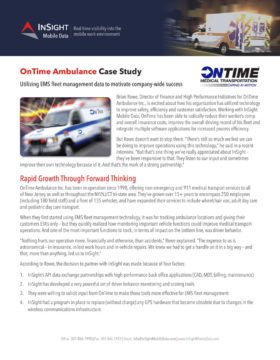The efficiency of dispatch operations is critical in emergency medical services. Any delays or miscommunications in the dispatch process can put lives at risk and lead to costly questions of legal liability.
EMS companies most often use computer-aided dispatch (CAD) systems to streamline communication between dispatchers and paramedics—but a lack of back-end integration often limits the benefits of these solutions. This article explains the core capabilities required for effective EMS dispatch and the value of integrating fleet dispatch software processes with billing and other back-end systems.
The Need for Dispatch Efficiency
The quality of the information available to dispatchers affects their decisions in emergency situations. There are two critical pieces of data required for effective EMS fleet management dispatch:
- Location—to ensure the closest available unit is dispatched and given accurate navigation information
- Crew status—to avoid unnecessary radio traffic and quickly identify the crew that is best positioned to respond
Equally important, dispatchers also need a reliable way to communicate routing information to EMS crews on the street, and ambulance drivers need in-cab navigation tools to ensure that they can get to their destination as quickly as possible.
OnTime Ambulance Case Study
Download the eBook to learn how OnTime
utilizes driver performance data to motivate
company-wide success. (PDF)
Shortcomings of Two-Way Radio
Two-way radios have been a mainstay of public safety and emergency response services for decades, but there are better options available to EMS companies in the 21st century. The shortcomings of using two-way radio for dispatching and routing include:
Radio traffic is one-to-many, but one-to-one communication is frequently needed for EMS fleet management. Dispatchers must communicate routing and patient information directly to specific ambulance crews, but the messages go out over the entire network—creating background chatter and impeding one-to-one exchanges.
Back-and-forth voice traffic can become noisy, adding to the confusion in an emergency situation. The lack of chatter-free one-to-one messaging can cause critical miscommunications that result in a delayed response.
There is no accurate, easily accessible record of events—impeding paramedics from verifying information, and making it difficult for EMS companies to ensure accuracy in billing and defend their performance in the event of an adverse patient outcome.
Radio messages are unstructured data that can’t be integrated into other systems. When data needs to be manually entered into multiple systems, the risk of error is greatly increased. Duplicate entry also becomes a time drain for back-office personnel.
The Benefits of an Integrated Dispatch and Routing Application
Modern EMS companies are using dispatch and routing applications with back-end integration to share location and status information between dispatchers and EMS crews—and capture accurate details of each trip in real time. This provides critical advantages to the organization as a whole.
Share Real-Time Location and Status Information Between Dispatchers and EMS Crews
Automatic vehicle location (AVL) is essential for a modern EMS operation. Ideally, dispatchers should know where each ambulance is and the crew’s current status—and be able to push navigation information directly to the unit being dispatched. These capabilities will help ensure the fastest possible response time.
Capture Accurate Details of Each Trip in Back-End Systems
An integrated application can capture precise details regarding the location, status, and navigation of an EMS crew—and feed the data directly into billing, HR, and other back-end systems. This significantly reduces the risk of potentially costly errors.
StreetEagle: The All-in-One EMS Fleet Management Platform
The growing popularity of smartphones and tablets has made it easier than ever to achieve integration and efficiency in all types of mobile work environments. The StreetEagle platform from InSight Mobile Data enables EMS companies to leverage the capabilities of employee or company-owned mobile devices with an integrated dispatch and routing application.
StreetEagle is an all-in-one platform with functionality that reaches far beyond dispatch and routing. EMS companies can also use the platform’s sophisticated driver behavior monitoring tools to improve safety, and increase vehicle efficiency with real-time equipment diagnostics and maintenance alerts. StreetEagle provides all the tools you need to achieve maximum accountability and performance in EMS operations.
Contact InSight Mobile Data to learn more about how EMS companies are benefitting from StreetEagle’s EMS fleet management software.


